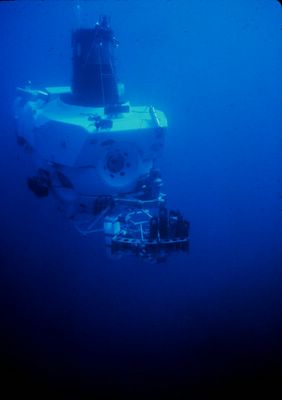
The submarine Nautilus attacked by a giant squid in Jules Verne's novel 20,000 Leagues Under the Sea .
Japanese scientists, Tsunemi Kubodera and Kyoichi Mori, report that they have made the world's first observations of a giant squid in the wild. The researchers followed sperm whales, that are known to feed on giant squid, to find a location for their attempted filming. A system of a robotic cameras tethered to buoys and baited with a bags of mashed shrimp were used.
At about 3000 feet and positioned about 1,000 feet above the seafloor lowest bait on the rig attracted a small Architeuthis measuring 26 feet in length. It is believed that the giant squid can grow as large as 60 feet.
Attracted by the bait the Architeuthis got caught in the bait and camera rig. The robotic camera then took pictures every 30 seconds of the giant squid for over 4 hours as it struggled to free itself.
Although Jules Verne's Captain Nemo encounter with Architeuthis was a work of fiction occasionally deep sea submersibles have run across the unexpected.
On December 20, 2001 NOAA scientists aboard the submersible Alvin encountered a 21-foot-long squid, dubbed the "Mystery Squid," while conducting an undersea project.

The Submersible Alvin (Source: NOAA)
The scientists were investigating gas hydrates in the Gulf of Mexico at a depth of approximately 6,300 feet below the surface when a 21 foot "Mystery Squid" drifted close to the submersible. The squid was captured on video before moving away after a few minutes.
NOAA scientists in 2001 could not be certain of the identity of the squid they encountered without capturing a specimen. The Japanese scientists who filmed the Architeuthis were fortunate in that a piece of the squid's tentacles was left behind after it escaped it's 4 hour entanglement. DNA analysis of that sample and other comparisons with squid that have washed ashore confirmed that it was an Architeuthis or Giant Squid.
For more information on Architeuthis go to the links page on The Search for Giant Squid webpage from a Smithsonian National Museum of Natural History 1999 exhibition.









No comments:
Post a Comment